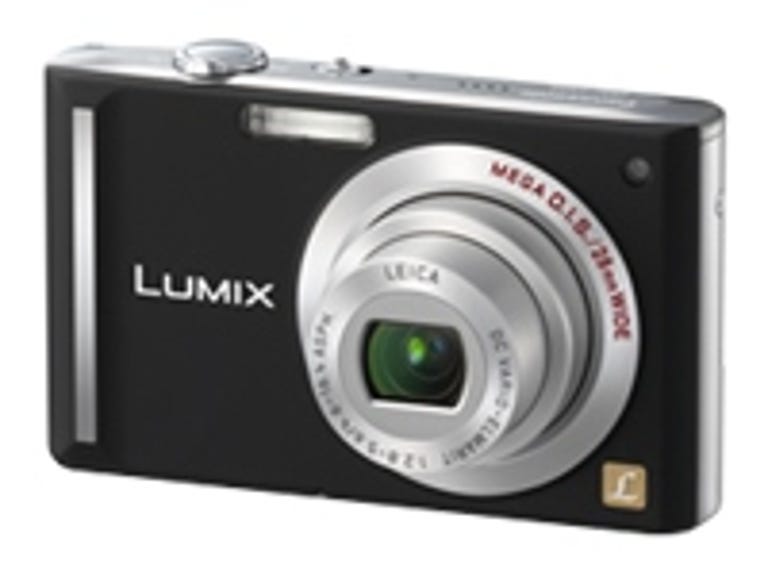 Why You Can Trust CNET
Why You Can Trust CNET Panasonic Lumix DMC-FX55 review: Panasonic Lumix DMC-FX55
Panasonic Lumix DMC-FX55
Panasonic's Lumix DMC-FX55 is a beautiful little camera. It has a clean, simple, and solid design that should appeal to most camera buyers. But in the world of cameras, beauty is only body-casing deep and it's what happens inside the camera that really counts. Unfortunately, the images that are captured and processed inside the DMC-FX55 fall a little short of the competition. That means that while it does include a lot of nice features, photographers who value image quality first should look elsewhere for a sleek, shiny pocket camera.
The Good
The Bad
The Bottom Line
The DMC-FX55's design defines simplicity. The 3-inch 230,000-pixel LCD screen leaves little room for buttons, but Panasonic includes a very nice, large joystick to access the mostly menu-driven controls. The joystick also provides quick access to exposure compensation, flash, the self-timer, and image review. Plus, pressing the joystick opens the menu. This makes operating the camera easy in that you don't need to learn the locations of buttons, but menu-driven controls can also be slower than the alternative. In the case of the DMC-FX55, this means that it takes seven button presses to change the ISO and get back to shooting. To Panasonic's credit, it did place white balance at the top of the menu, so that it can be changed quicker. I guess Panasonic thinks that users will want to change that more frequently than ISO.
While the large LCD looks impressive, it forces you to grip the camera along the narrow right-hand edge, especially since the indented portion on the front of the camera is very close to the edge as well. I found this uncomfortable. Panasonic would have been better off sticking with the design of the front of last year's DMC-FX50, which had a nook closer to the middle of the front of the camera. Of course, holding the camera with two hands, something I always suggest to keep the camera steadier, mitigates most of these gripes.
Like most compact cameras, the FX55 doesn't include manual exposure controls. Instead Panasonic includes a bevy of scene modes to cover shooting situations that might confuse the camera's auto mode. New to the Panasonic feature list this year is the company's Intelligent Auto mode. It activates the camera's optical image stabilization, Intelligent ISO Control, which automatically boosts the ISO to keep a fast shutter speed and combat hand shake, and Intelligent Scene Selector, which analyzes what's in the frame and chooses what it thinks is the correct scene mode for the given situation. This mode also activates continuous auto focus, so that you don't have to press the shutter button halfway to prefocus and the camera can capture a photo faster than if it needs to focus before snapping a photo. Meanwhile, the camera's Face Detection system can find faces in the frame and use them to set focus and exposure so that the camera won't try to focus or expose for something else in the frame instead of your friends and family.
An 8.1-megapixel CCD sensor is at the heart of the DMC-FX55's imaging system. A 3.6x optical, 28-100mm f/2.8-5.6 Leica DC Vario-Elmarit lens feeds light to the sensor, while Panasonic's Venus Engine III processes the images captured by the sensor. Sensitivity ranges from ISO 100 to ISO 1,600 at full resolution. Panasonic advertises that the camera can extend to ISO 6,400, but you have to access a special high-sensitivity scene mode that automatically selects an ISO between 1,600 and 6,400, but also reduces the pixel resolution to 3 megapixels. Similarly, the camera offers a High-Speed Burst mode in addition to the normal burst mode, though that'll cost you even more pixels, reducing the pixel count to 2 megapixels. Since Panasonic is fond of marketing hype, the company misleadingly labels the digital zoom, another resolution-robbing feature, Extra Optical Zoom.
In our lab's performance tests, the Lumix DMC-FX55 fared well, but was no speed demon. The camera started up and captured its first JPEG in 1.4 seconds. Thereafter, the camera took 1.8 seconds between images with the flash turned off and a slightly sluggish 2.3 seconds between photos with the flash turned on. Shutter lag measured an impressive 0.6 second in our high-contrast test and 1.3 seconds in our low-contrast test, which mimic bright and dim shooting conditions, respectively. The camera did live up to Panasonic's claims in burst mode, capturing an average of 3.3 frames per second regardless of image size, though it is limited to 4 images per burst in fine JPEG mode and 7 per burst in the lower quality standard JPEG mode.
Though the FX55 fares well in some aspects of image quality--its exposure, white balance, and color are impressive--the camera's image quality falls apart when it comes to noise. I saw noise even at the lowest sensitivity setting of ISO 100. At ISO 200, Panasonic was already engaging a noticeable blur filter to keep noise from getting out of control, though at the expense of sharpness, which means a loss of fine detail. At ISO 400 noise increases more and more detail is lost, though there is still a decent amount of shadow detail present and you should be able to get acceptable prints. Noise increases precipitously at ISO 800, with even more loss of fine and shadow detail and finally plummets off the deep end at ISO 1,600. I recommend staying below ISO 800 when shooting with the Lumix DMC-FX55.
Noise has always been Panasonic's Achilles' heel and continues to dog their compact cameras. If they could only get that under control, they'd stack up better against the competition. As it stands, you'd be better served going for something along the lines of Canon's PowerShot SD870 IS or Sony's Cyber-shot DSC-T100.
(Shorter bars indicate better performance)
| Typical shot-to-shot time | Time to first shot | Shutter lag (typical) |
(Longer bars indicate better performance)
